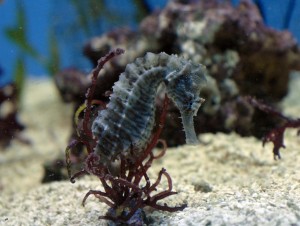We have many lectures and seminars at the aquarium, and we try and keep them aimed at the general public in terms of content and level. There’s not much point having someone come in to talk about a rare species of worm if no one is going to show up.
A couple of months ago, we Skyped in a presenter from Project Seahorse, who talked about this most beautiful of fish, one that always attracts visitors in every aquarium, regardless of the species. The presentation was very interesting, but also very disturbing. Seahorses are perfect poster subjects for hitting the emotions, and so the tales of how pollution, climate change, wild collection and traditional medicine uses have decimated some species, were difficult to take.
Seahorses, of course, are not the only creatures out there in trouble. Nor are they the only fish collected in the wild simply to satisfy the cravings of hobbyists and the aquarium industry. When aquariums started in the mid-19th Century in England, and for many decades afterwards, collection was the only means of populating tanks. And it wasn’t usually done in the most environmentally friendly of ways. It’s not just aquariums that suffered from this manner of collection – zoos and circuses also teetered wildly from the extremes of ethical and non-ethical means of adding to their displays.
In the past few decades, however, ethics have taken a much more central role in how aquariums and zoos go about their business. It’s no longer purely about entertainment, but also education. There are also organizations in North America that regulate and observe facilities to ensure standards are met. And many facilities have not only education programs, but also breeding and conservation programs to study species of interest. In some cases, they are even able to reintroduce species to the wild.
Captive breeding is generally done on a small scale, but there are also larger scale aquaculture programs in existence, although most are for farming of species that are important on a commercial scale, such as salmon. Farmed salmon have often raised ethical issues, but there’s little doubt that aquaculture is here to stay and other species can be raised for other purposes.
Seahorses can be raised in captivity, as can many species, but raising them in large numbers can often prove challenging. Studies have been done on the optimal temperatures, salinity, density, daylength, feeding and other factors. But juvenile mortality is always an issue, as are hatching rates, which for some species rarely hit 50 per cent.
The other factor is cost. Buying a seahorse from an internet aquarium supplier can range from $35 to $100, although most are in the $60-65 range. Factoring in all of the costs associated with their production and rearing, captive-bred specimens can be quite a bit more expensive than their wild-caught counterparts.
Which raises the question – would you be prepared to pay quite a bit more for some creatures if you knew that your purchase was helping the environment and the wild survival of the species?

